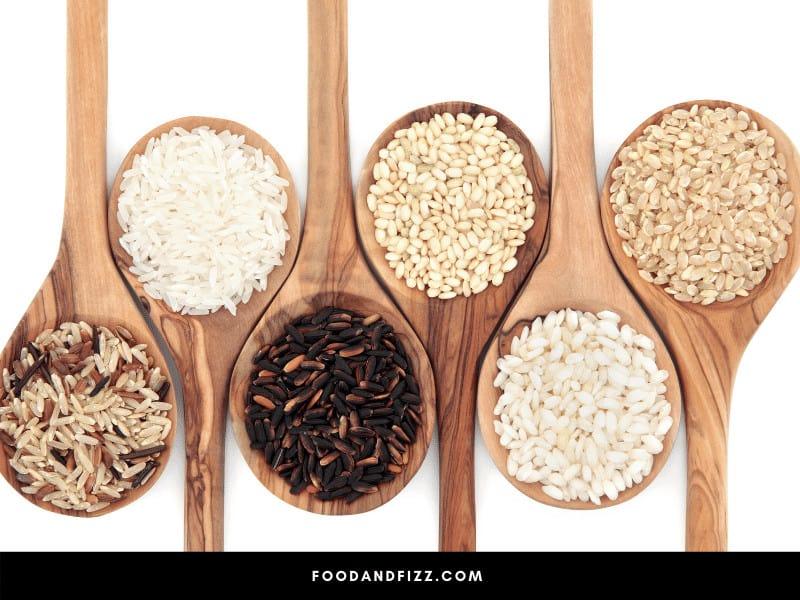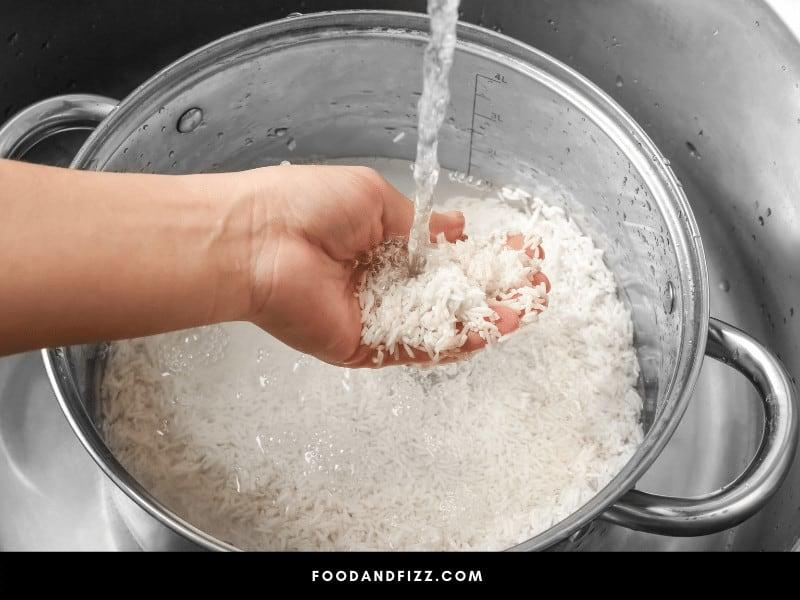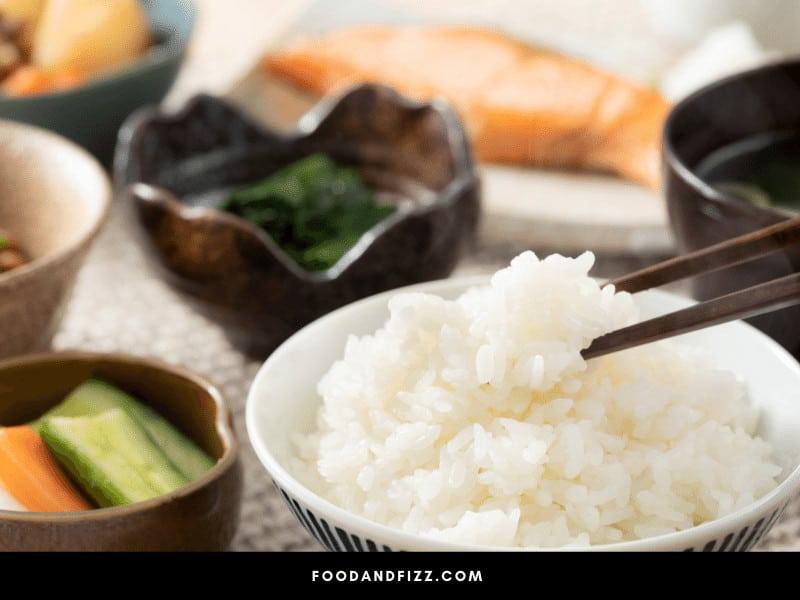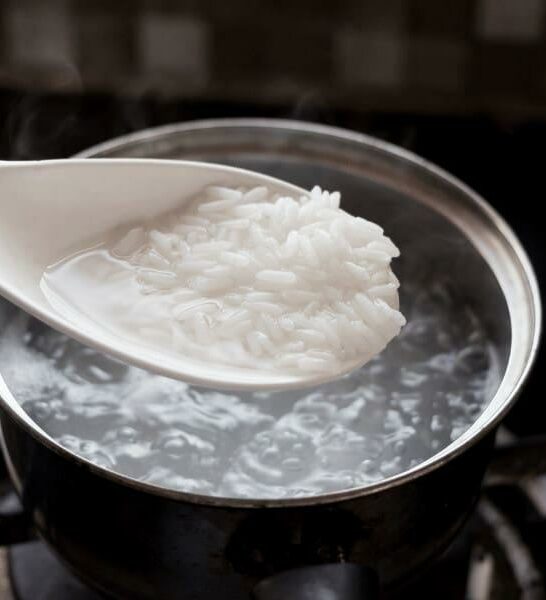The smell of rice cooking in the kitchen is one of the most comforting things to me, growing up in a household that has rice as one of its staple foods.
It signals to my brain (and tummy!) that mealtime is near, and that delicious, heartwarming food is just around the corner.
I’ve also often observed rice as it cooked on the pot and watched in wonder at how the addition of water and heat transformed those little grains into fluffy bites of goodness.
It starts out quiet at first, and over the course of a few minutes, little bubbles start to appear on the surface.
These little bubbles multiply and become bigger and bigger and vigorously dance on the surface of the rice. Soon it becomes quiet again when the water is finally absorbed, and just like that, the rice is done.
So, why is my rice bubbling? What’s up with all the dancing bubbles that are not there when say, I boil broccoli? There are 2 reasons for this.
Why is My Rice Bubbling?
Rice is bubbling because rice is a starchy food. Bubbles form when rice is boiled in water. The starch coating the grains interacts with the boiling water and causes bubbles to form. These bubbles are then pushed up by the steam as the rice is cooking. The second reason is that bubbles are formed by the interaction of water and the starch in the rice. The more water you have in a pot, the more bubbles you get, and the more vigorous these bubbles dance as the rice cooks.

2 Reasons Why Your Rice is Bubbling
There are two main reasons why you might notice that your rice is bubbling as it cooks.
1. Starch Content
As with all grains, rice contains a lot of starch. The starch coating each grain of rice interacts with the boiling water and causes foaming, soapy bubbles to form as it cooks. The more starch content your grain has, the more bubbles will form.
In general, long-grain rice varieties like Basmati Rice will have less starch content than their short-grain counterparts, for example, Arborio rice (traditionally used in risottos).
Starch also plays a factor in whether your rice will be sticky or fluffy. Depending on what dish you are making, both have advantages and disadvantages.
Pilafs would do well with less starchy varieties as they need to be fluffy and mostly separate, but creamy risottos and sushi rice, by their very nature, would need to be made with starchier, short-grain varieties.
It would just ultimately depend on what your purpose is.

2. Excess Water
Adding too much water to the pot of rice may cause more bubbles to form and may sometimes even lead to water and rice bubbling over the pot. To prevent this, make sure to use the right water-to-rice ratios, and make sure to always use the right pot size.
2 Ways to Cook Rice
There are two ways that you can cook rice. One method is on the stove top. The other one is with the rice cooker.
1. Stovetop Cooking
Rice can be cooked using any deep pot with a lid on the stovetop. At a ratio of 2 cups water for 1 cup rice for white rice and 2 ½ to 2 ¾ cups water to 1 cup of brown rice, you can have perfectly cooked rice in about 20 minutes.
Boil water before adding your rinsed rice, lower to a simmer, and cover partially with a lid. This is important especially if your lid does not have a small hole to allow steam to escape.
This releases some of the pressure from the bubbles and rising steam as the rice cooks and prevents your pot from boiling over and making a mess on the stovetop.
Check rice often and do not wait for the water to completely dry up before removing it from heat, covering it, and allowing it to rest. It will continue to cook and absorb water as it sits.
After waiting a few minutes, you can use a fork to lightly fluff the rice. This ensures that the grains won’t stick together which can result in clumpy rice.
2. Rice Cooker
One of the great inventions in cooking gadgets is the rice cooker. This is becoming more and more of a staple in most kitchens because of its ease of use and practicality. Aside from rice, it can also cook other things like vegetables and meat, and you can even use the rice cooker to cook beans.
This handy kitchen appliance gives you perfectly cooked rice in about the same time, or even less time than cooking on a stovetop, and the beauty of it all is that you do not have to constantly watch it and monitor it.
You measure the rice and water, turn it on, and it will magically do what it’s supposed to do. It will automatically stop cooking when the rice is done and will switch to a “keep warm” setting instead, allowing you the option to keep your rice warm if you’re not serving it right away.
To cook rice in a rice cooker, simply measure 1 cup of rinsed white rice and add 1 cup of water or 1 cup of rinsed brown rice and add 2 cups of water, cover with the lid, push start and that’s it.
When the rice is done cooking, it will smartly turn off or switch to a setting that will allow you to keep the rice warm prior to serving. It literally can’t get any easier than this!

How to Cook the Perfect Pot of Rice
As we have seen above, there is a perfect ratio to cook rice depending on the variety and depending on whether you will cook it on the stovetop or a rice cooker.
So how do we achieve the perfect pot of fluffy rice? Follow the tips below:
1. Rinse rice
Rinse your rice once or twice to remove excess starch and remove any dirt or impurities that have been packed in your bag of rice. This is especially important for brown rice.
2. Measure the right amount of rice and add the right amount of water
Perfectly cooked rice is all about the right texture, and this can be achieved by following the recommended water-to-rice ratios.
3. Bring to a boil, lower to a simmer, and partially cover with a lid if cooking on the stovetop
If cooking on the stovetop, make sure to bring water to a boil first before adding the rice, and lowering to a simmer the rest of the way through. Place the lid on the pot but make sure that it is only partially covered in order to release some of the steam.
4 . Let it Rest
When water is almost fully absorbed, remove from heat (if cooking on stovetop), cover with a lid, and allow it to rest for about 5 minutes. This allows the rice grains to recover and firm up a little bit, resulting in a fluffy texture with a tender bite. Trust me, the wait is worth it!
5. Fluff and Enjoy
After resting, fluff with a fork, transfer to a bowl, and enjoy!
How Do I Minimize Rice Bubbling?
Rice bubbling while cooking is normal but if you wish to minimize all the bubbling, there are a few precautions you can take.
1. Rinse the rice
Rinsing not only removes dirt and impurities from the rice grains, but it also washes away the excess starch coating the grains. By removing excess starch, you minimize the amount of starch that interacts with the boiling water as it cooks. Wash rice three to four times or until the water is clear.
(Fun Fact: In some parts of the world, this “starchy rice water” is used as a base in soups and dishes and lends an earthy quality to the overall flavor of the dish).

2. Soak the rice
Soaking, like rinsing, also removes all the extra starch that coats the rice grains. But an added benefit of soaking is that makes the rice cook a little bit more quickly. The longer you soak the rice (up to overnight), the quicker it will cook.
Add a little oil or some butter to the pot
The oil will create a sort of barrier between the rice grains coated in starch and the water and minimize the foaming and bubbling action. I would use something that’s neutral-tasting and not overpowering, and I would only use a little bit.
3. Use a large enough pot
Rice needs space to cook so it is important to use the right size of pot for the amount of rice you will be making. A pot that’s too small would not leave much space for the rice to cook and may even make a mess in your kitchen.
4. Make sure to follow the right ratios
Adding the right amount of water will help ensure that unnecessary bubbles are not created and will ensure that rice is cooked properly.
5. Use a different kind of rice variety
To minimize bubbling, you can also choose a rice variety that has less starch content. Long-grain varieties like Basmati Rice have less starch content than the short-grain varieties like Arborio or Bomba Rice. Basmati Rice would create fewer bubbles while cooking.
Conclusion To Why Is My Rice Bubbling
Rice is a staple food in many countries because it is economical and readily available, and it has a lot of nutritional benefits. Rice that’s bubbling while cooking is normal. It is because of the interaction of the water and the starch and is of no cause for concern.
There are many things you can do and many precautions you can take to minimize rice bubbling while you are cooking it, but if you are like me, I do not mind it at all.
As long as you follow the right proportions and the right procedure, bubbling rice will still give you that perfect pot of goodness with its health benefits intact.

Frequently Asked Questions On Why is My Rice Bubbling?
Is it better to cook on the stove or rice cooker?
Both methods can lead to perfectly cooked rice as long as you follow the right ratios for the type of rice you are making but cooking on the rice cooker has the added benefit that you do not need to constantly watch the rice as it cooks. It will stop cooking automatically when the rice is done, and switch to a “keep warm” mode. This is especially handy when you are making a lot of dishes at the same time.
How can I get rid of the bubbles while the rice is cooking?
As rice is by nature a starchy food, you cannot completely get rid of the bubbles as it cooks, but you can minimize it. Washing the rice several times prior to cooking, adding a little fat to create a barrier between the water and the starch, using the right water-to-rice ratios, using the right pot size, and choosing long-grain rice over short-grain rice are some ways you can minimize rice bubbling while cooking.

